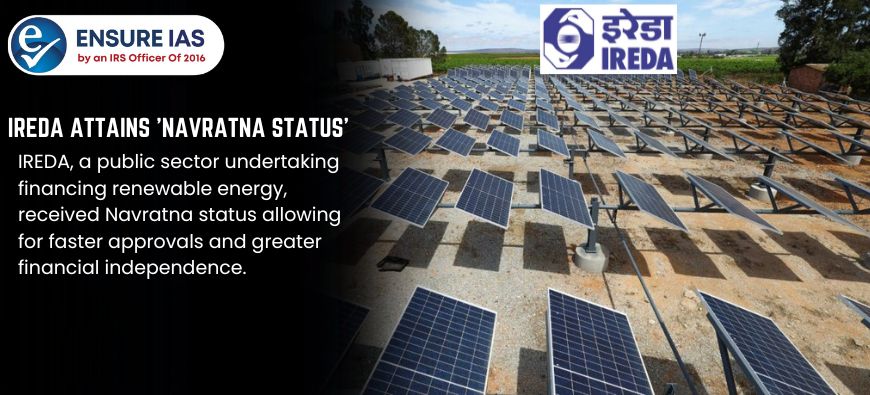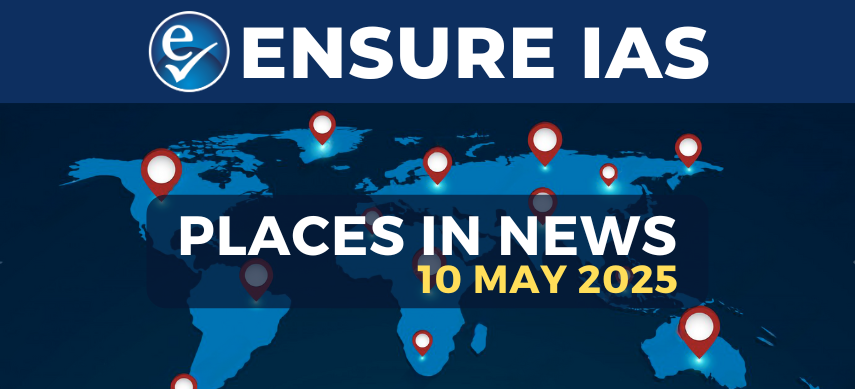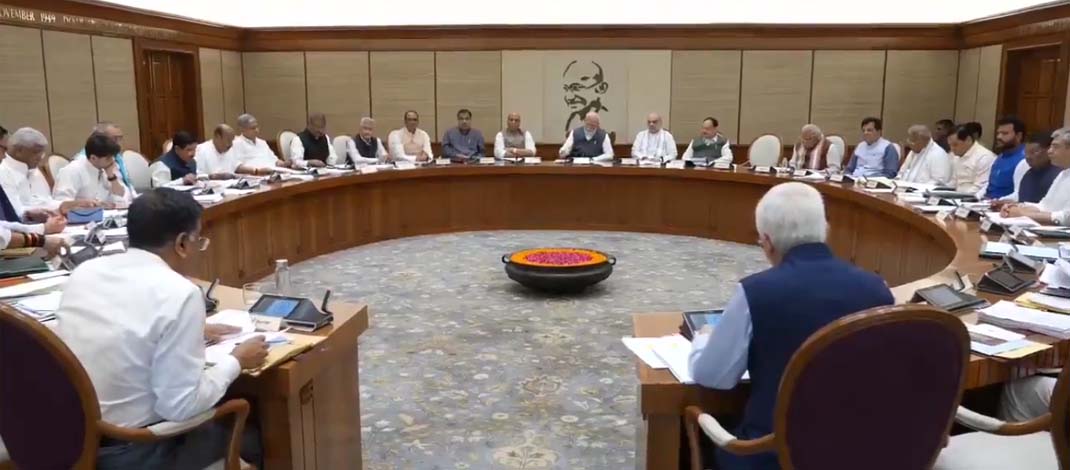- Courses
- GS Full Course 1 Year
- GS Full Course 2 Year
- GS Full Course 3 Year
- GS Full Course Till Selection
- Online Program
- GS Recorded Course
- NCERT (Recorded 500+ Hours)
- Polity Recorded Course
- Geography Recorded Course
- Economy Recorded Course
- AMAC Recorded Course
- Modern India, Post Independence & World History
- Environment Recoded Course
- Governance Recoded Course
- Science & Tech. Recoded Course
- International Relations and Internal Security Recorded Course
- Disaster Management Module Course
- Ethics Recoded Course
- Essay Recoded Course
- Current Affairs Recoded Course
- CSAT
- 5 LAYERED ARJUNA Mentorship
- Public Administration Optional
- ABOUT US
- OUR TOPPERS
- TEST SERIES
- FREE STUDY MATERIAL
- VIDEOS
- CONTACT US
IREDA Attains 'Navratna status'
IREDA Attains 'Navratna status'

The Department of Public Enterprises recently granted Navratna status to the Indian Renewable Energy Development Agency, a public sector undertaking.
- IREDA has now attained the Navratna status and has a faster approval process in place.
- no external interference for opening of subsidiaries, opening of branches, etc.
About Navratna Status:
- The government categorizes public sector undertakings (PSUs) into 3 groups:
- Maharatna
- Navratna
- Miniratna
- The "Navratna" program was implemented by the government in 1997.
Criteria for Navratna Status:
- A PSU must be a Schedule 'A' Miniratna-I company, have received a rating of "excellent" or "very good" in a memorandum of understanding (MoU) in 3 of the last 5 years
- Should have a composite score of 60 in 6 performance indicators.
Benefits of Navratna Status:
- Financial Independence: They invest up to ₹1,000 crore without seeking approval from the central government.
- Navratna companies are also allowed to invest up to 15% of their net worth in a single project, or 30% of their net worth in a given year, subject to a cap of ₹1,000 crore.
- To make capital expenditure without any monetary limit for purchase or replacement of new goods.
- Enter into technology joint ventures or strategic alliances.
Q: What is Public Sector Undertakings?
Public Sector Undertakings (PSUs) are government-owned companies or enterprises in India. They play a significant role in the Indian economy.
Key Features
- Ownership: The central or state governments hold a majority stake (at least 51%) in PSUs. This means the government has significant control over their operations.
- Purpose: PSUs were established to achieve various socio-economic goals such as:
- Infrastructure development: Building critical infrastructure like power plants, roads, railways, etc.
- Strategic industries: Operating in sectors like defense, oil, and gas that are important for national security.
- Social welfare: Providing essential services like healthcare and education at affordable prices, especially in remote areas.
- Economic development: Promoting balanced regional growth and employment generation.
Types of PSUs
PSUs in India fall into a few categories:
- Central Public Sector Enterprises (CPSEs): These are owned and primarily managed by the central government. Examples include ONGC (Oil and Natural Gas Corporation), IOCL (Indian Oil Corporation Limited), and BHEL (Bharat Heavy Electricals Limited).
- State Level Public Enterprises (SLPEs): These are owned and primarily managed by individual state governments.
- Statutory corporations: These are established through a special Act of Parliament and have a distinct legal structure. Examples are the Life Insurance Corporation of India (LIC) and the Food Corporation of India (FCI).
Classification Based on their profitability, Indian CPSEs are further classified into:
- Maharatnas: The largest and most profitable CPSEs with significant global presence.
- Navratnas: Profitable CPSEs with the potential to become Maharatnas.
- Miniratnas: Less profitable CPSEs, but still strategically important.
Criteria for grant of Maharatna status to CPSEs:
The CPSEs meeting the following criteria are eligible to be considered for grant of Maharatna status.
- Having Navratna status
- Listed on Indian stock exchange with minimum prescribed public shareholding under SEBI regulations
- An average annual turnover of more than Rs. 25,000 crore during the last 3 years
- An average annual net worth of more than Rs. 15,000 crore during the last 3 years
- An average annual net profit after tax of more than Rs. 5,000 crore during the last 3 years
- Should have significant global presence/international operations.
|
Difference between turnover and net profit
|
Criteria for grant of Navratna status to CPSEs:
- The CPSEs which are Miniratna I, Schedule ‘A’ and have obtained ‘excellent’ or ‘very good’ MOU rating in 3 of the last 5 years
- having composite score of 60 or above in 6 selected performance indicators are eligible to be considered for grant of Navratna status.
Criteria for grant of Miniratna status to CPSEs:
Miniratna Category-I status: - The CPSEs which have made profit in the last 3 years continuously, pre-tax profit is Rs.30 crores or more in at least one of the 3 years and have a positive net worth are eligible to be considered for grant of Miniratna-I status.
Miniratna Category-II status: - The CPSEs which have made profit for the last 3 years continuously and have a positive net worth are eligible to be considered for grant of Miniratna-II status.
- Miniratna CPSEs should have not defaulted in the repayment of loans/interest payment on any loans due to the Government.
- Miniratna CPSEs shall not depend upon budgetary support or Government guarantees.
|
Classification |
Description |
Criteria |
|
Maharatnas |
Largest and most profitable CPSEs with significant global presence |
|
|
Navratnas |
Profitable CPSEs with the potential to become Maharatnas |
|
|
Miniratna (Category-I) |
Less profitable CPSEs, but still strategically important |
|
|
Miniratna (Category-II) |
Less profitable CPSEs, but still strategically important |
|


